
We’re staying at the Grecotel Eva Palace overlooking Kommeno Bay and Corfu Town. It is one of the most beautiful views we’ve ever had from a hotel room terrace. We’ve been taking the same photo for days; view at dawn, view at 10am, at 5pm, sunset, night with the lights of Corfu town in the distance. It’s so beautiful we could just sit on the terrace for hours or days.
Grecotels are designed with family entertainment in mind. They’re kind of like beached cruise ships. There is a big buffet breakfast (included in the room cost) but for those who wish, they can also have the full board which includes the buffet lunch and the buffet dinner. I’m not a big buffet fan; too much food. You feel like you’ve got to eat too much. I haven’t been able to eat that much since I was 16 and the local Howard Johnson’s had all you could eat Wednesdays.
Grecotel Guests are “urged” to sign up for the hotel activities; Morning dance, Afternoon Fit , Jive Dance, Aqua Gym, Cocktail lessons (I don’t know if it’s how to make them or how to drink them), Greek language lessons, Snorkel lessons, water-ski, sailboard and sailing lessons, motorboat rentals. trips to nearby islands and Greek Cooking classes.
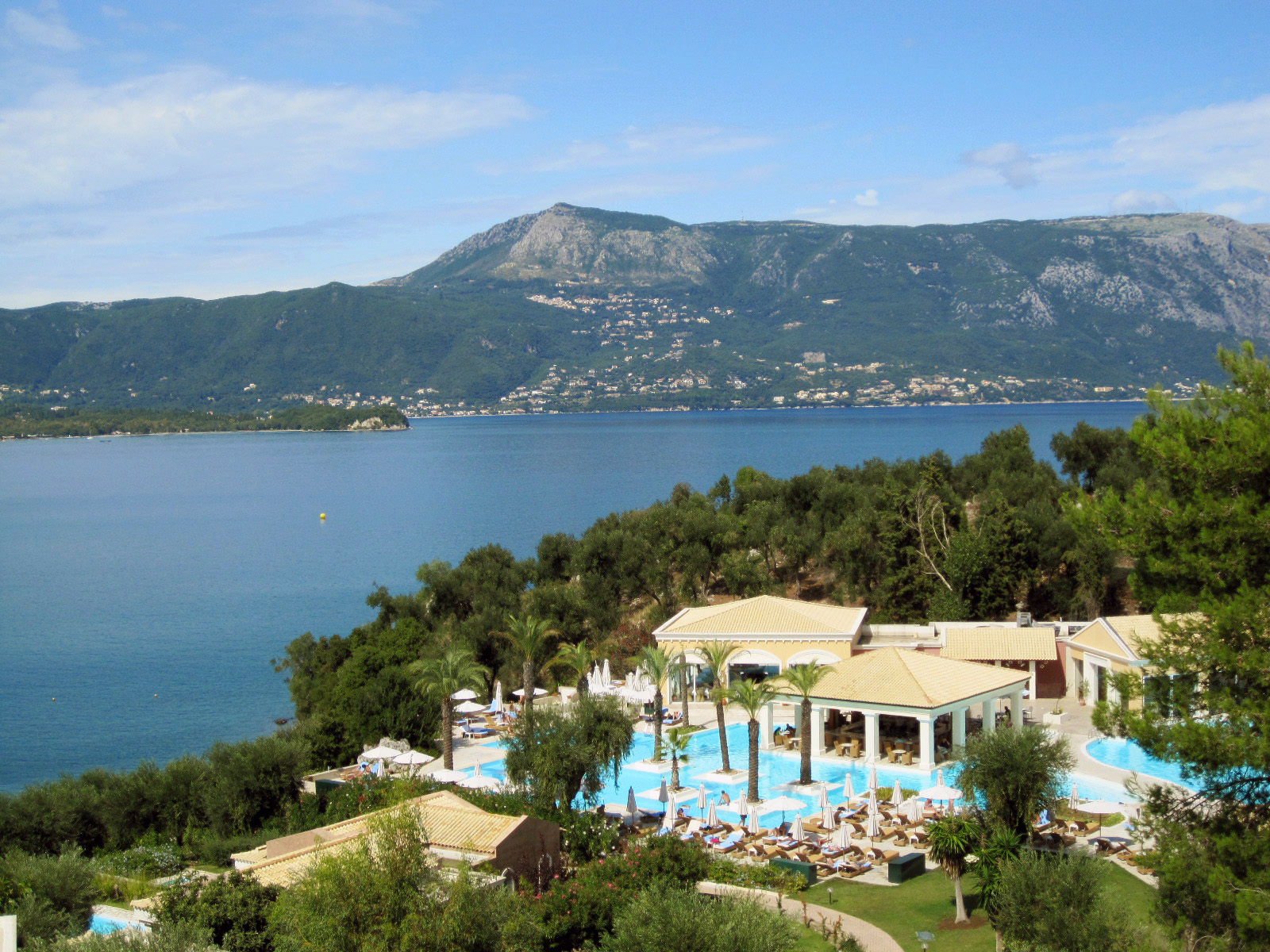 Musical entertainment is provided 3 nights a week at the pool bar and every Thursday is “Lobster Night” at the al la carte restaurant near the pool, which is odd because there are no lobsters in the Ionian sea.
Musical entertainment is provided 3 nights a week at the pool bar and every Thursday is “Lobster Night” at the al la carte restaurant near the pool, which is odd because there are no lobsters in the Ionian sea.
We watched it all from our terrace and pretty much stayed to ourselves. Oh, I almost forgot, there was another Grecotel (The Imperial) about ¼ mile away. We never went over there but I’m sure they have more to offer the beached cruiseship guests. I’m not complaining here. I love the Grecotels. If you’re coming for a relaxing quiet visit to Corfu, just make sure you’re stay there is not during the summer family season. We’re here in late September and it’s fairly quiet.
We watched the glorious view, hung out at the pool or the hotel beach, surfed the internet in the hotel lobby and drove down the road every night to the Taberna Greco, a quiet place with soft Greek music and lots of German tourists. In the 5 nights we stayed on Kommeno Bay we spent 4 of them at the Taberna Greco and pretty much covered all the traditional Greek foods on the menu.
The Greek name for the island (and the town) is Kerkyra from the old Corinthian name Korkyra of the 5th century BC, named after Korkyra, a young nymph abducted by Poseidon, who brought her to this island.
The name Corfu is an English name given to the island while the Brits were here from 1815-1864. The Greek word “koryfo” is the summit of the twin peaks of the old fortress hill, now covered with the old Fortress.
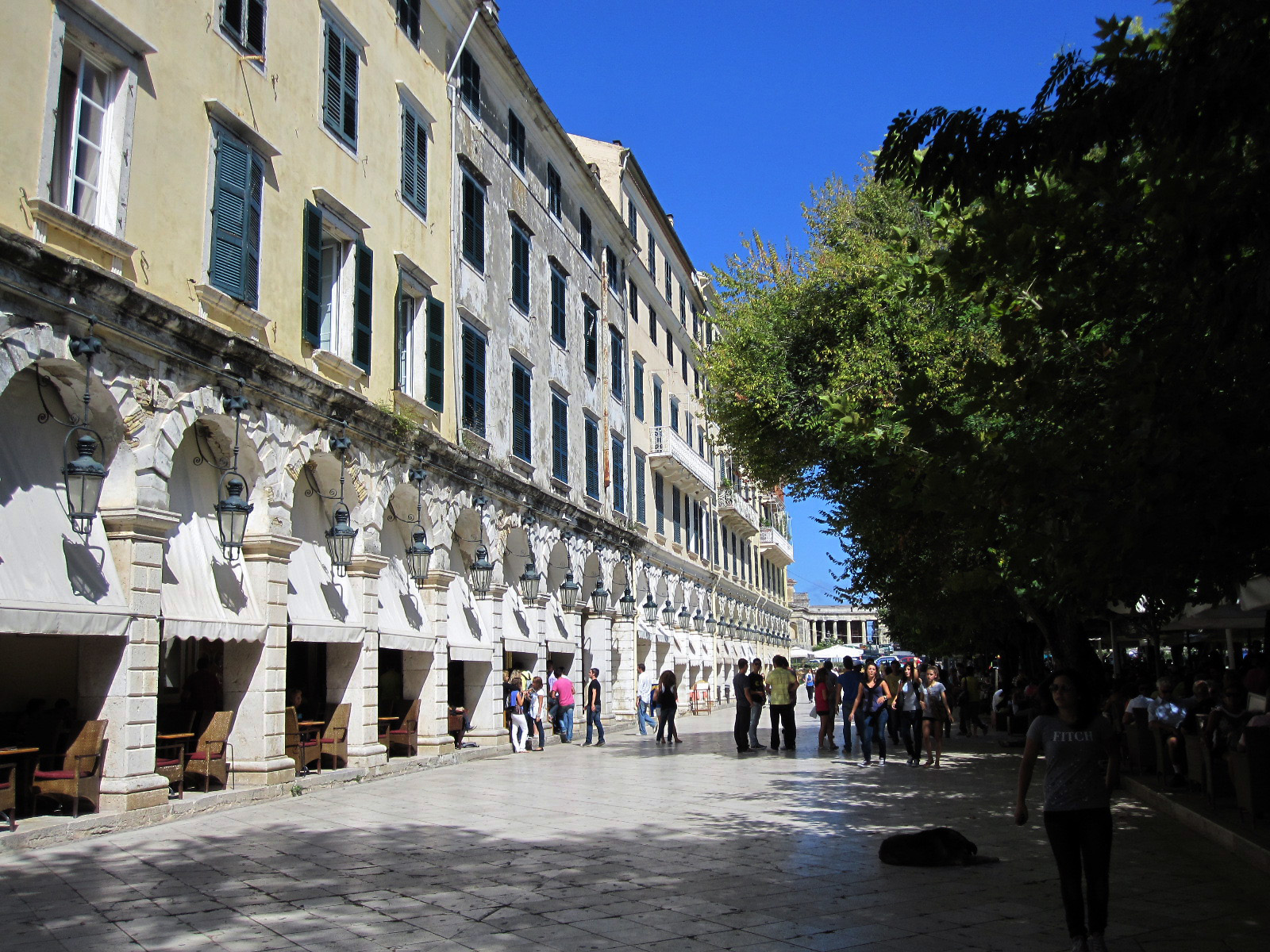 Corfu Town (or Kerkya) was under Venetian rule from 1386 till 1797, which is why the city has such a Venetian look to it, although the grand arcade known as the Liston (which is very similar to the Arcades of the Piazza San Marco in Venice) was actually designed and built under Napoleon’s occupation of the island in 1807 by Mathieu de Lesseps (the father of Ferdinand de Lesseps, the engineer of the Suez Canal). The Liston is a wonderful place to grab a cool refreshing beverage and watch the people walk by on a hot day, but you will pay for the pleasure of the location.
Corfu Town (or Kerkya) was under Venetian rule from 1386 till 1797, which is why the city has such a Venetian look to it, although the grand arcade known as the Liston (which is very similar to the Arcades of the Piazza San Marco in Venice) was actually designed and built under Napoleon’s occupation of the island in 1807 by Mathieu de Lesseps (the father of Ferdinand de Lesseps, the engineer of the Suez Canal). The Liston is a wonderful place to grab a cool refreshing beverage and watch the people walk by on a hot day, but you will pay for the pleasure of the location.
Corfu town is built between the two imposing fortresses, the Old Fortress and the New fortress.
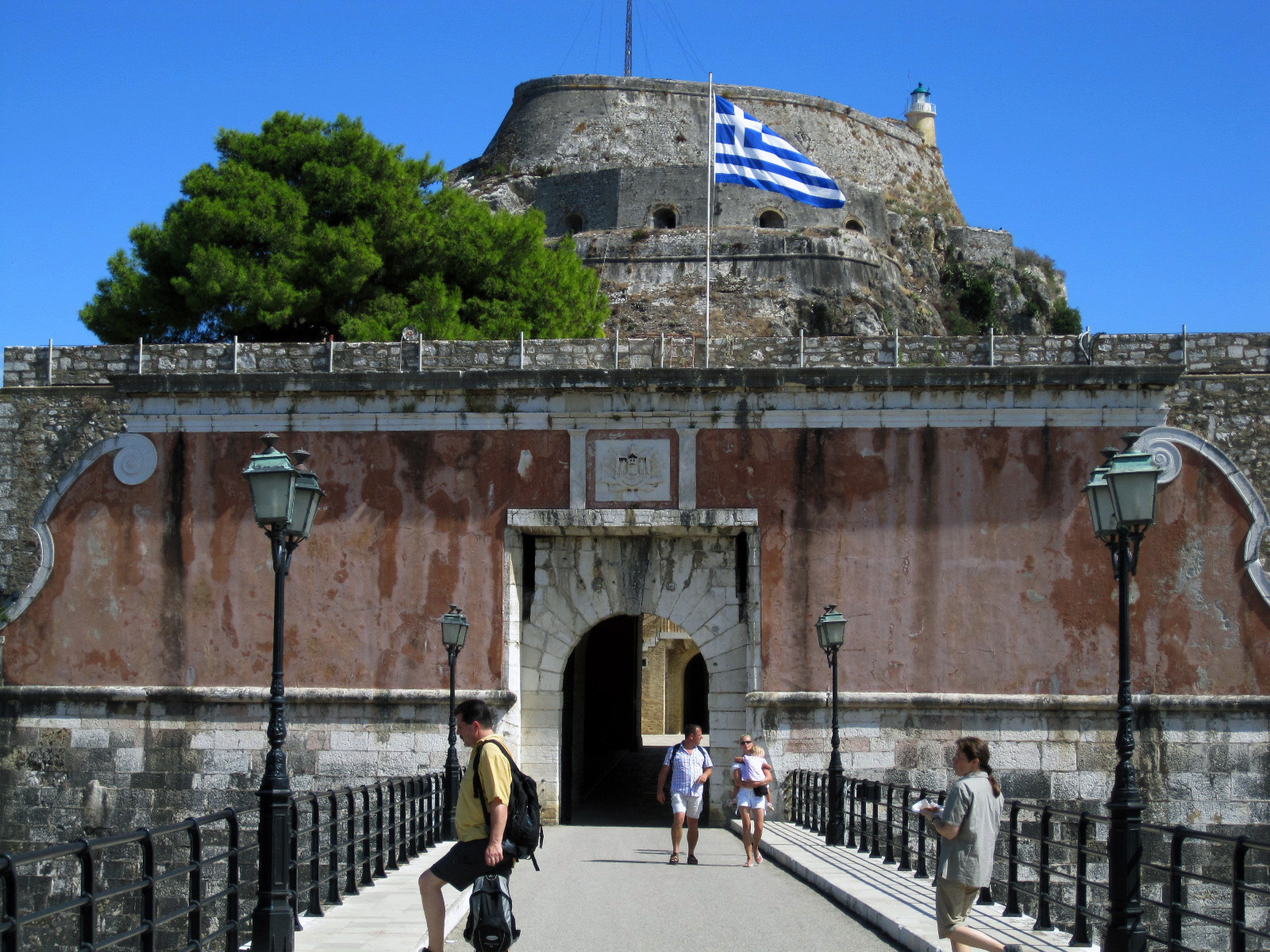 The twin peaks of the old fortress rock were originally fortified by the Byzantines and later by the successor of the Byzantine Empire, the Desponate of Epiros in the early 13th century.
The twin peaks of the old fortress rock were originally fortified by the Byzantines and later by the successor of the Byzantine Empire, the Desponate of Epiros in the early 13th century.
In the 15th and 16th centuries, the Venetians, who were constantly at war with the Turks built most of the fortress we see here there today. It was never breached by land or sea. It held out against the Ottoman Turks in 1537 and again in 1571, 1573 and 1716. There are 2 moats to the castle called the Contrafossa (one outside and one inside). What a surprise to get across one moat only to find another one inside; pretty clever. However, a lot of the old fortress was torn down when the British occupied the island. A lot more was bombed out during World War II.
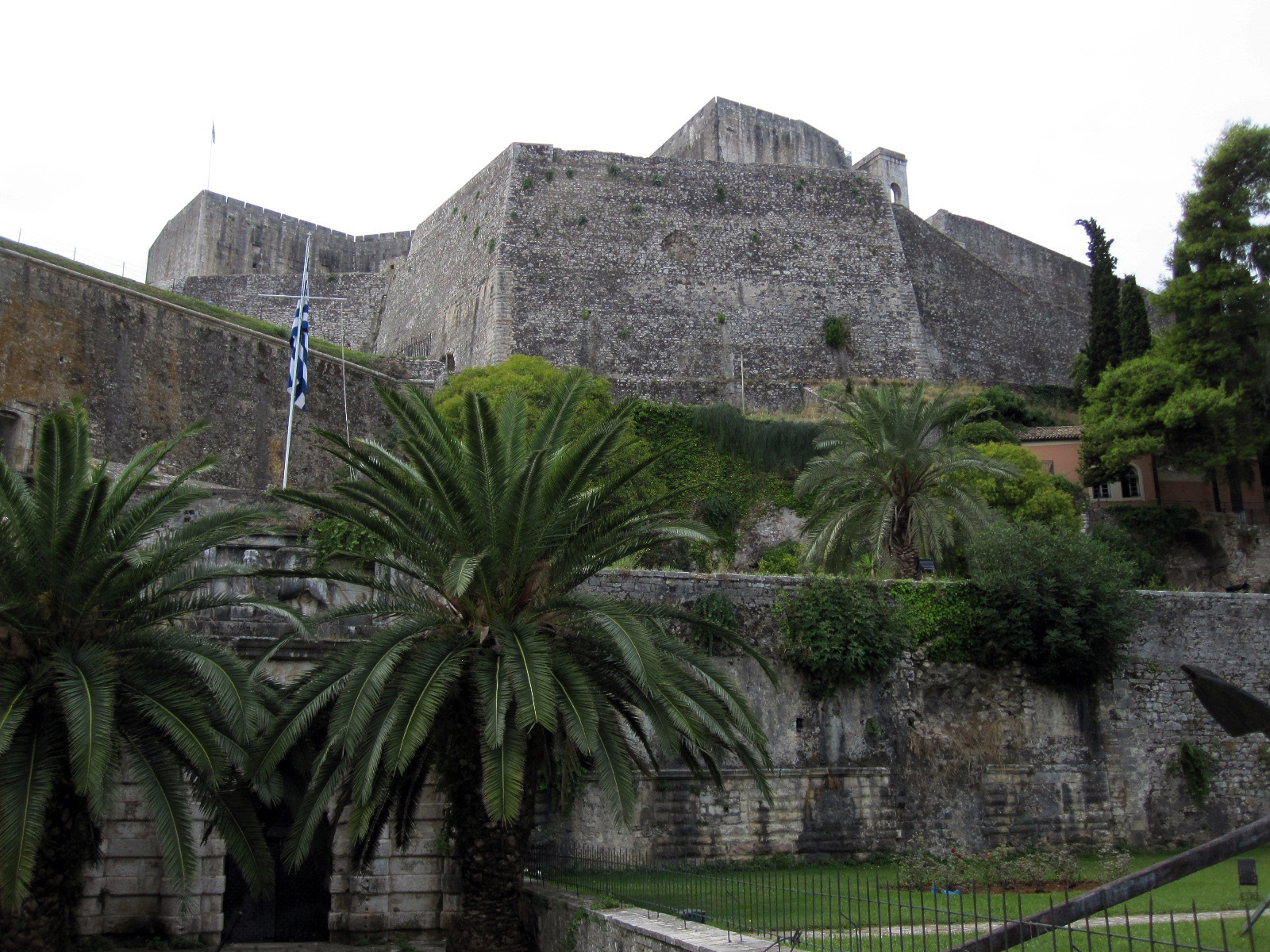 The new fortress was built in the 16th century. A wall once ran from one fortress to the other and totally protected the town.
The new fortress was built in the 16th century. A wall once ran from one fortress to the other and totally protected the town.
Today the remains of the two fortresses draw the skyline of the city but the city wall came down a long time ago. There are still a few of the gates designed into some of the 17th century buildings but if you didn’t know about the fortress wall you’d never know they were entry ports.
The streets of Corfu Town are filled with tourist shops, and why not, the main industry of the town is tourism. We were here towards the end of the season. The tourists were few and the shop keepers were exhausted. While we were in the “old town” (where the streets are narrower than the new town), we stopped in a shop that sold ouzo and other local alcoholic firewater. I asked if they might know where we could buy a bottle of good Greek wine. The woman turned to me and said, “I’m sorry, we just sell tourist things here.” And there you have it.
The tourist season starts in April and finishes on the last day of September. Whenever we asked anyone what they’ll do between October and April, they just smiled and said “we’ll enjoy ourselves”.
From the old Fortress, it’s about a 10 minute walk to the Archeology museum, a small but impressive collection of pieces found on the island. Corfu played a good sized role in the Glory Days of ancient Greece. It was settled by the Corinthians (from Peloponnese) and was established as a good trade port. During the Peloponnesian War (431BC-404BC), Corfu sided with Athens and the Delian League instead of with Corinth and the Peloponnesian League. It proved to be a bad decision and after Athens was defeated, Corinth took revenge on Kerkyra.
 I love museums with only a few really important pieces. This one is a 30 minute walk through small bronze statues, pottery, deity votives, ancient coins and a few really spectacular pediments and marble sculptures, including the lifesize 7th century BC lion of Menekrates. The prize of the museum though is the Gorgon Pediment of the Doric Temple of Artemis, built between 590BC and 580BC.
I love museums with only a few really important pieces. This one is a 30 minute walk through small bronze statues, pottery, deity votives, ancient coins and a few really spectacular pediments and marble sculptures, including the lifesize 7th century BC lion of Menekrates. The prize of the museum though is the Gorgon Pediment of the Doric Temple of Artemis, built between 590BC and 580BC.
Next to the Lion’s Gate of Mycenae (in Peloponesse), this is the second oldest pediment relic of Ancient Greece. It shows the Gorgon, Medusa with her two sons, Pegasus and Chrysaor, who sprang out of her blood after her head was lopped off by Perseus, who also shows up in the pediment. Medusa is seated with a panther to one side and a lion to the other, but I have no idea of why these big cats are there.
At the triangular corners are the enemies of the Greeks, the Trojans on one side and the Giants on the other. These supposedly represent any intruder from the outside world. The pediment (which is about 50’ wide) was meant to be a warning to outsiders. The image of the Medusa is so large, it pops out of the pediment border, which is actually a very modern approach to art. I wonder if the artist understood the irony in turning Medusa into stone.
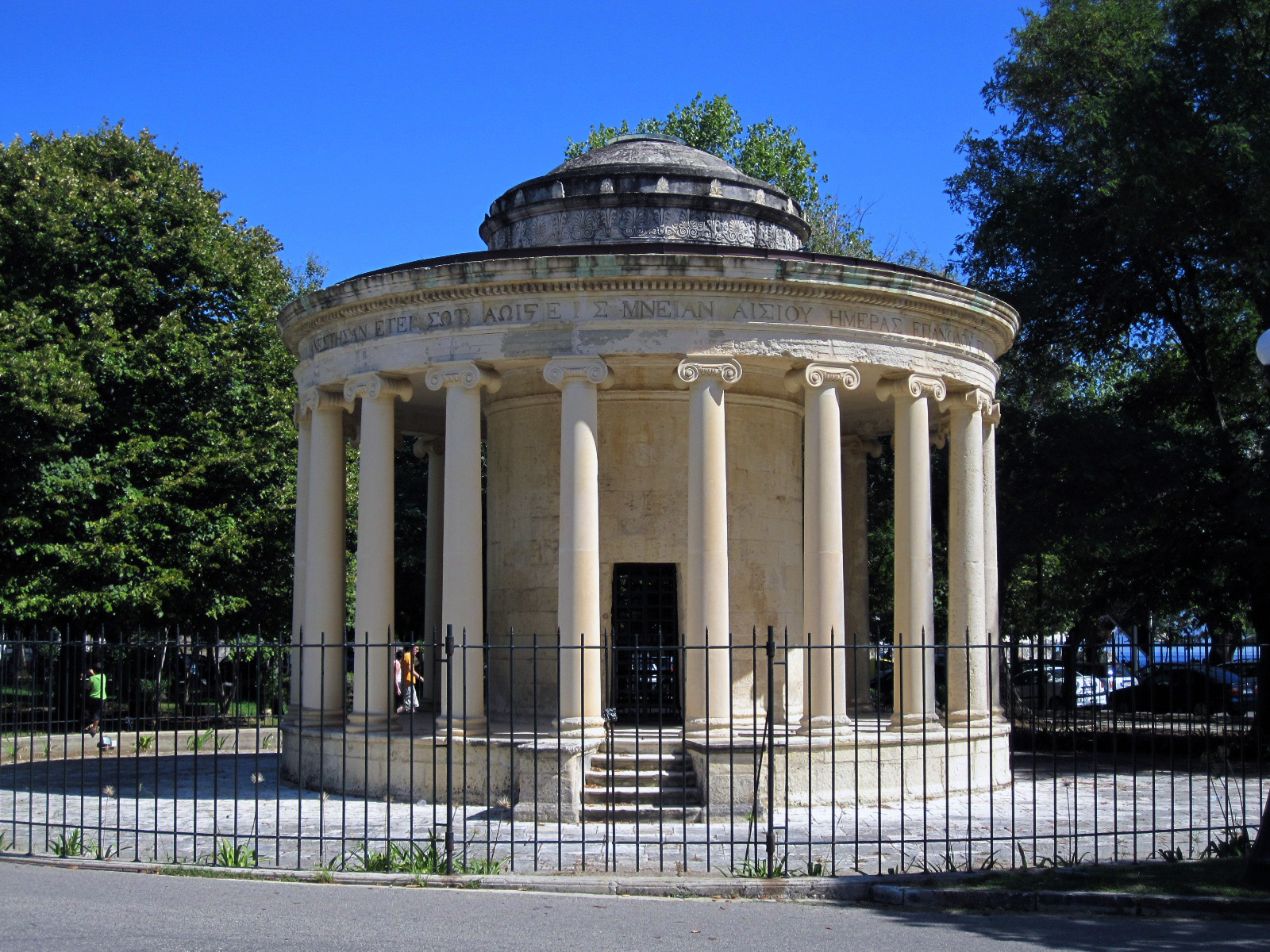 Inside the Spianada, the park that sprawls out between the old fortress and the arcades of the Liston sits the Maitland Peristyle , a circular porch supported by Ionic colums that was erected in 1816 in honor of Thomas Maitland, the first British High commissioner of the Ionian islands.
Inside the Spianada, the park that sprawls out between the old fortress and the arcades of the Liston sits the Maitland Peristyle , a circular porch supported by Ionic colums that was erected in 1816 in honor of Thomas Maitland, the first British High commissioner of the Ionian islands.
It’s a pretty building in a very tranquil setting. It’s known to the locals as the “Sterna” (water tank) because it’s the entrance to the underground water system.
 The tallest point of he Corfu town skyline is the red spire of the Church of St Spyridon, the patron saint of the city and inside of the church is the relic of the larynx of the Saint. Spyridon died in the 4th century, but his spirit (or ghost) made quite a few appearances. He saved the island from famine in 1553. He saved the people from the plagues of 1629 and 1673 and he saved the town from the Turkish invasion of 1716. His larynx is paraded through the streets at least three times a years.
The tallest point of he Corfu town skyline is the red spire of the Church of St Spyridon, the patron saint of the city and inside of the church is the relic of the larynx of the Saint. Spyridon died in the 4th century, but his spirit (or ghost) made quite a few appearances. He saved the island from famine in 1553. He saved the people from the plagues of 1629 and 1673 and he saved the town from the Turkish invasion of 1716. His larynx is paraded through the streets at least three times a years.
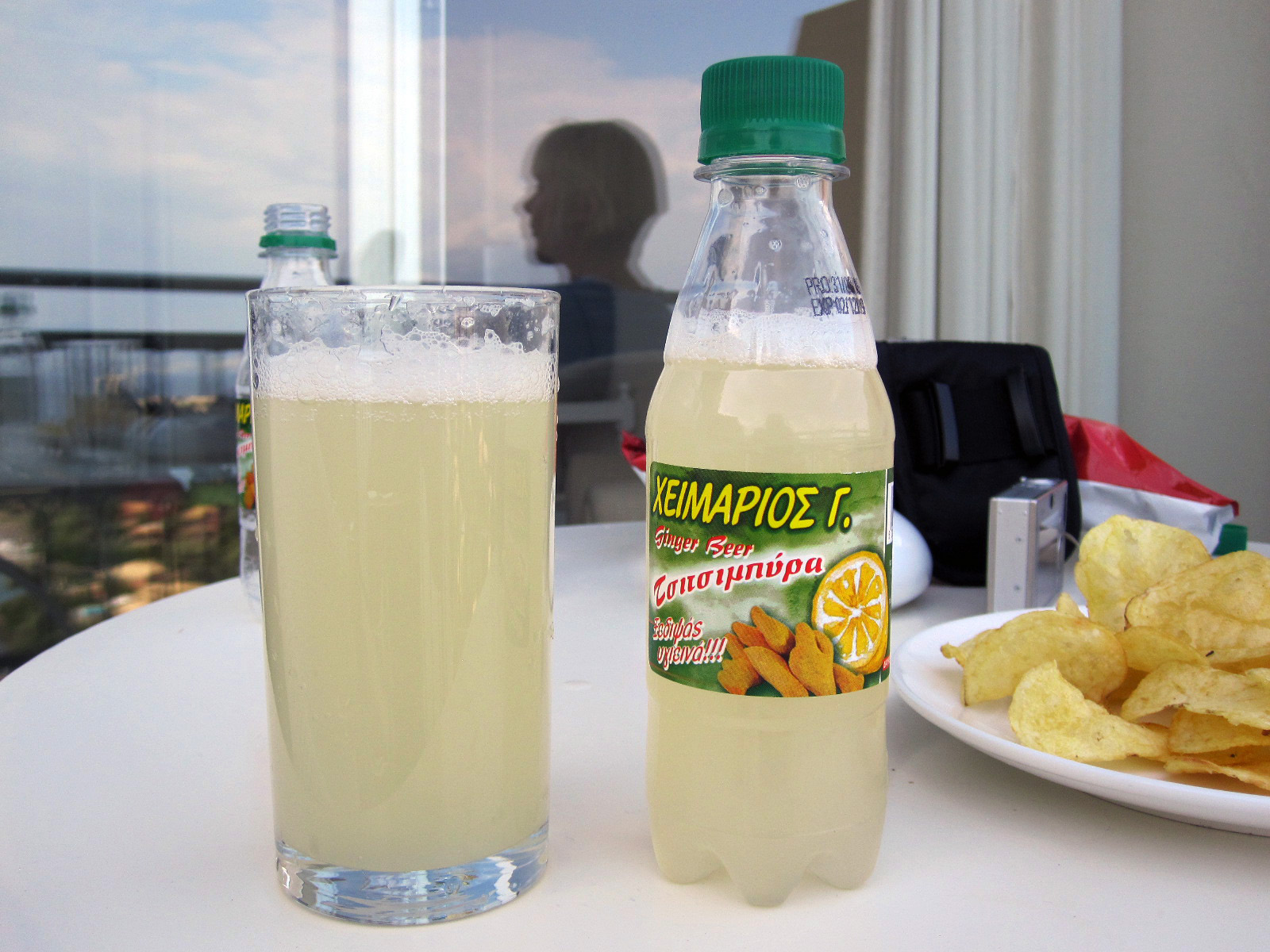 One of the best treats of Corfu (for me) is the tsitsibirra, the local ginger beer, a leftover from the British rule. I’m a big fan of ginger beer and this is one of the best version ever. Corfu tsitsibirra is prepared with fresh lemon juice, water, sugar and ginger brought from the East. During the British colonial era, the mixture was fermented in stone jars submerged in cold well water for about 3 weeks. But now, thanks to modern tsitsibirra technology, it needs about five days to mature. When you pop one of these little bottles open you really get a good head of foam. The island has been drinking tsitsibirra since 1860. I wish I could find it in San Francisco
One of the best treats of Corfu (for me) is the tsitsibirra, the local ginger beer, a leftover from the British rule. I’m a big fan of ginger beer and this is one of the best version ever. Corfu tsitsibirra is prepared with fresh lemon juice, water, sugar and ginger brought from the East. During the British colonial era, the mixture was fermented in stone jars submerged in cold well water for about 3 weeks. But now, thanks to modern tsitsibirra technology, it needs about five days to mature. When you pop one of these little bottles open you really get a good head of foam. The island has been drinking tsitsibirra since 1860. I wish I could find it in San Francisco
After a day in Corfu Town we decided to take a car trip and see what else was on the island, Corfu is pretty substantial and it can take hours to get from one end of the island to the other. The guide books tell you about all the beaches where people go to see and be seen; some very private, some with spectacular rock formations, nude beaches and family beaches. We drove past some of them, but none were that much better than the pretty spectacular beachfront setting at our hotel on Kommeno Bay.
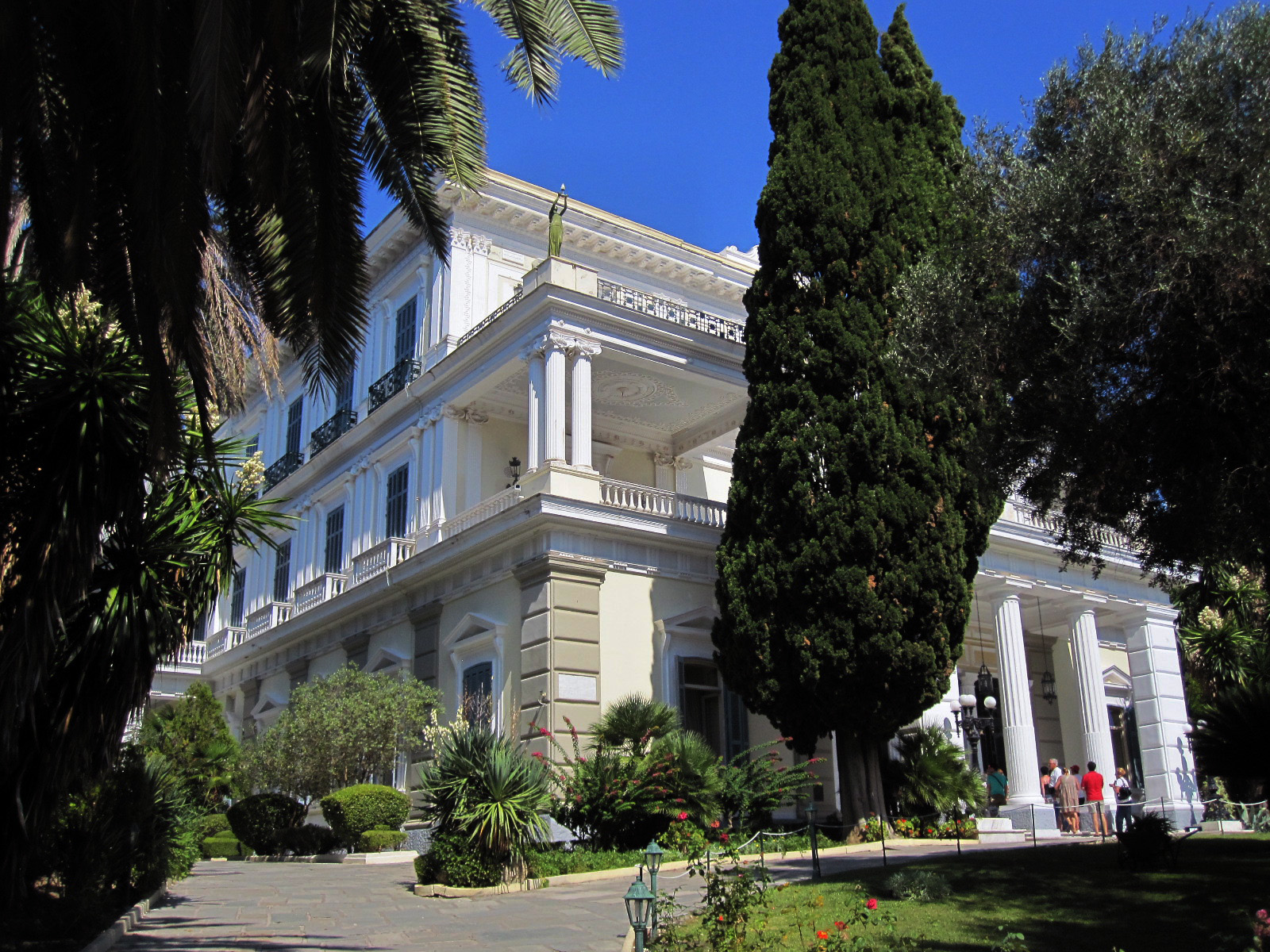 We decided to head out towards the Acheleio (the summer Palace of Empress Elisabeth (Sissi) of Austria.
We decided to head out towards the Acheleio (the summer Palace of Empress Elisabeth (Sissi) of Austria.
According to Homer, Corfu might have been the island of Scheria, the place where Odysseus landed on his way back home from Troy after escaping from Calypso’s island of Ogygia. I don’t know if Sissi knew this or not. The Greek island reminded her more of Achilles (who supposedly came from near Mt Pelion in southeastern Thessaly).
Sissi fell in love with the area and in 1890, built this neo-classical monument to the Greek warrior. The gardens are crowded with classical statues. The interior is painted with scenes of Achilles in battle. It’s hard to get a feel of what went on there though. Did she entertain?.
We’ve run into Sissy a few times in our travels, mostly in Vienna and Dubrovnik. She was married to Emperor Franz Joseph of the Austro-Hungarian Empire (the man who brought the World into the 1st World War, but died before the battle began). After Sissi fulfilled her royal duties of having three children (2 girls and a boy) she went on to enjoy her own life, not really caring for the pomposity of the Hapsburg court. She was obsessed with art and beauty, mostly her own beauty (in particular, her weight), occasionally restricting her intake to only raw veal juice. Her waistline never, ever was allowed to exceed 20”.
 Sissy liked to travel, she had a few affairs, she enjoyed her Palaces and children, and on September 10, 1898, in Geneva, Switzerland, at age 60, she was stabbed to death with a needle file by a young anarchist named Luigi Lucheni. He was looking to kill a Prince from the House of Orléans, but when the prince was a no show, he killed Sissi instead. As Lucheni said later on, “I wanted to kill a royal. It did not matter which one.”
Sissy liked to travel, she had a few affairs, she enjoyed her Palaces and children, and on September 10, 1898, in Geneva, Switzerland, at age 60, she was stabbed to death with a needle file by a young anarchist named Luigi Lucheni. He was looking to kill a Prince from the House of Orléans, but when the prince was a no show, he killed Sissi instead. As Lucheni said later on, “I wanted to kill a royal. It did not matter which one.”
After Siss’s death, the Achilleio was sold to Kaiser Wilhelm II of Germany in 1906. He made a few changes, added even more statues and used it as his summer residence. At the end of World War I, it passed on to the state. During World War II it was used by both the Italians and the Germans as HQ; and why not.
It became a casino for a while. It appeared in a James Bond film “For Your Eyes Only” and today it’s a museum. The casino moved over to the Aquis Corfu Holiday Palace (previously the Corfu Hilton).
From the Achilleion, we got in the car and drove south to Lefkimmi, the second largest town on the island with a nice beach and a small river. To be honest we’re still wondering if we actually were there. We were definitely in a town with a large church and old houses sleeping along the abandoned streets. I understand we were there during the 4 hr lunch break, but we thought we’d at least find a place for lunch or a cool beverage. Nope, the whole town was “out to lunch”. After a long drive down a winding road to get there it was a longer drive back, Leftkimmi is our new word for “not worth the effort”.
Corfu is a great place to unwind. Corfu Town is a good for restaurants and couple of days for sightseeing and the Achilleion is definitely worth the drive. Other than that, grab a book and a chaise lounge and enjoy the sun, sand and surf or just the view from the terrace. It’s Greece. Relax.
You must be logged in to post a comment.